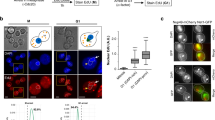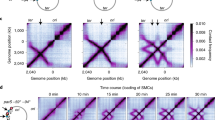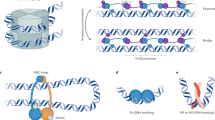Abstract
All organisms, from bacteria to humans, face the daunting task of replicating, packaging and segregating up to two metres (about 6 × 109 base pairs) of DNA when each cell divides. This task is carried out up to a trillion times during the development of a human from a single fertilized cell. The strategy by which DNA is replicated is now well understood. But when it comes to packaging and segregating a genome, the mechanisms are only beginning to be understood and are often as variable as the organisms in which they are studied.
This is a preview of subscription content, access via your institution
Access options
Subscribe to this journal
Receive 51 print issues and online access
$199.00 per year
only $3.90 per issue
Buy this article
- Purchase on Springer Link
- Instant access to full article PDF
Prices may be subject to local taxes which are calculated during checkout





Similar content being viewed by others
References
Mogilner, A. & Oster, G. Polymer motors: pushing out the front and pulling up the back. Curr. Biol. 13, R721–R733 (2003).
Wolgemuth, C. W., Mogilner, A. & Oster, G. The hydration dynamics of polyelectrolyte gels with applications to cell motility and drug delivery. Eur. Biophys. J. 33, 146–158 (2004).
Mazumder, A. & Shivashankar, G. V. Gold-nanoparticle-assisted laser perturbation of chromatin assembly reveals unusual aspects of nuclear architecture within living cells. Biophys. J. 93, 2209–2216 (2007).
Mazumder, A., Roopa, T., Basu, A., Mahadevan, L. & Shivashankar, G. V. Dynamics of chromatin decondensation reveals the structural integrity of a mechanically prestressed nucleus. Biophys. J. 95, 3028–3035 (2008).
Jun, S. & Mulder, B. Entropy-driven spatial organization of highly confined polymers: lessons for the bacterial chromosome. Proc. Natl Acad. Sci. USA 103, 12388–12393 (2006).
Rao, V. B. & Feiss, M. The bacteriophage DNA packaging motor. Annu. Rev. Genet. 42, 647–681 (2008).
Finzi, L. & Gelles, J. Measurement of lactose repressor-mediated loop formation and breakdown in single DNA molecules. Science 267, 378–380 (1995).
Bianco, P. R. et al. Processive translocation and DNA unwinding by individual RecBCD enzyme molecules. Nature 409, 374–378 (2001).
Wang, M. D. et al. Force and velocity measured for single molecules of RNA polymerase. Science 282, 902–907 (1998).
Yin, H. et al. Transcription against an applied force. Science 270, 1653–1657 (1995).
Dworkin, J. & Losick, R. Does RNA polymerase help drive chromosome segregation in bacteria? Proc. Natl Acad. Sci. USA 99, 14089–14094 (2002).
Holm, C., Goto, T., Wang, J. C. & Botstein, D. DNA topoisomerase II is required at the time of mitosis in yeast. Cell 41, 553–563 (1985).
Emanuel, M., Radja, N. H., Henriksson, A. & Schiessel, H. The physics behind the larger scale organization of DNA in eukaryotes. Phys. Biol. 6, 25008 (2009).
Towles, K. B., Beausang, J. F., Garcia, H. G., Phillips, R. & Nelson, P. C. First-principles calculation of DNA looping in tethered particle experiments. Phys. Biol. 6, 25001 (2009).
Pope, L. H., Xiong, C. & Marko, J. F. Proteolysis of mitotic chromosomes induces gradual and anisotropic decondensation correlated with a reduction of elastic modulus and structural sensitivity to rarely cutting restriction enzymes. Mol. Biol. Cell 17, 104–113 (2006).
Hirano, T. At the heart of the chromosome: SMC proteins in action. Nature Rev. Mol. Cell Biol. 7, 311–322 (2006).
Yeh, E. et al. Pericentric chromatin is organized into an intramolecular loop in mitosis. Curr. Biol. 18, 81–90 (2008). Pericentromeric chromatin adopts an intramolecular loop that is stretched between sister centromeres in mitosis. It is proposed that these loops function as DNA springs in the mitotic spindle.
Doi, M. & Edwards, S. The Theory of Polymer Dynamics (Oxford Univ. Press, 1992).
Okumura, Y. & Ito, K. The Polyrotaxane gel: a topological gel by figure-of-eight cross-links. Adv. Mater. 13, 485–487 (2001).
Daneholt, B., Anderson, K. & Fagerlind, M. Large-sized polysomes in Chironomus tentans salivary glands and their relation to Balbiani ring 75S. RNA. J. Cell Biol. 73, 149–160 (1977).
Gall, J. G. in Methods in Cell Physiology Vol. II (ed. Prescott, D. M.) 37–60 (Academic, 1966).
Paulson, J. R. & Laemmli, U. K. The structure of histone-depleted metaphase chromosomes. Cell 12, 817–828 (1977).
Sullivan, N. L., Marquis, K. A. & Rudner, D. Z. Recruitment of SMC by ParB–ParS organizes the origin region and promotes efficient chromosome segregation. Cell 137, 697–707 (2009). This study shows that SMC protein components localize to the origin of replication in B. subtilis and demonstrates that chromosome condensation coupled to replication is a major mechanism of chromosome segregation in bacteria.
Sumara, I., Vorlaufer, E., Gieffers, C., Peters, B. H. & Peters, J. M. Characterization of vertebrate cohesin complexes and their regulation in prophase. J. Cell Biol. 151, 749–762 (2000).
Waizenegger, I. C., Hauf, S., Meinke, A. & Peters, J. M. Two distinct pathways remove mammalian cohesin from chromosome arms in prophase and from centromeres in anaphase. Cell 103, 399–410 (2000).
Harrison, B. D., Hoang, M. L. & Bloom, K. Persistent mechanical linkage between sister chromatids throughout anaphase. Chromosoma 118, 633–645 (2009).
Paliulis, L. V. & Nicklas, R. B. Micromanipulation of chromosomes reveals that cohesion release during cell division is gradual and does not require tension. Curr. Biol. 14, 2124–2129 (2004).
Storlazzi, A. et al. Coupling meiotic chromosome axis integrity to recombination. Genes Dev. 22, 796–809 (2008).
Obermayer, B., Mobius, W., Hallatschek, O., Frey, E. & Kroy, K. Freely relaxing polymers remember how they were straightened. Phys. Rev. E 79, 021804 (2009).
Meaburn, K. J. & Misteli, T. Chromosome territories. Nature 445, 379–381 (2007).
Austin, S. & Abeles, A. Partition of unit-copy miniplasmids to daughter cells. II. The partition region of miniplasmid P1 encodes an essential protein and a centromere-like site at which it acts. J. Mol. Biol. 169, 373–387 (1983).
Ogura, T. & Hiraga, S. Partition mechanism of F plasmid: two plasmid gene-encoded products and a cis-acting region are involved in partition. Cell 32, 351–360 (1983).
Schumacher, M. A. Structural biology of plasmid partition: uncovering the molecular mechanisms of DNA segregation. Biochem. J. 412, 1–18 (2008).
Lynch, A. S. & Wang, J. C. Use of an inducible site-specific recombinase to probe the structure of protein–DNA complexes involved in F plasmid partition in Escherichia coli. J. Mol. Biol. 236, 679–684 (1994).
Clarke, L. & Carbon, J. Isolation of a yeast centromere and construction of functional small circular chromosomes. Nature 287, 504–509 (1980).
Furuyama, T. & Henikoff, S. Centromeric nucleosomes induce positive DNA supercoils. Cell 138, 104–113 (2009). This paper reports that the direction of DNA coiling around histone complexes containing the centromere-specific histone variant CENP-A is opposite to the canonical negative supercoils around histones. This is one of several features that distinguish centromeric chromatin from the rest of the genome.
Strahl, B. D. & Allis, C. D. The language of covalent histone modifications. Nature 403, 41–45 (2000).
Dalal, Y., Furuyama, T., Vermaak, D. & Henikoff, S. Structure, dynamics, and evolution of centromeric nucleosomes. Proc. Natl Acad. Sci. USA 104, 15974–15981 (2007).
Dalal, Y., Wang, H., Lindsay, S. & Henikoff, S. Tetrameric structure of centromeric nucleosomes in interphase Drosophila cells. PLoS Biol. 5, e218 (2007).
Hill, A. & Bloom, K. Genetic manipulation of centromere function. Mol. Cell. Biol. 7, 2397–2405 (1987).
Collins, K. A., Castillo, A. R., Tatsutani, S. Y. & Biggins, S. De novo kinetochore assembly requires the centromeric histone H3 variant. Mol. Biol. Cell 16, 5649–5660 (2005).
Hamiche, A. et al. Interaction of the histone (H3−H4)2 tetramer of the nucleosome with positively supercoiled DNA minicircles: potential flipping of the protein from a left- to a right-handed superhelical form. Proc. Natl Acad. Sci. USA 93, 7588–7593 (1996).
Bancaud, A. et al. Nucleosome chiral transition under positive torsional stress in single chromatin fibers. Mol. Cell 27, 135–147 (2007).
Selvin, P. R. et al. Torsional rigidity of positively and negatively supercoiled DNA. Science 255, 82–85 (1992).
Bloom, K. S. & Carbon, J. Yeast centromere DNA is in a unique and highly ordered structure in chromosomes and small circular minichromosomes. Cell 29, 305–317 (1982).
Folco, H. D., Pidoux, A. L., Urano, T. & Allshire, R. C. Heterochromatin and RNAi are required to establish CENP-A chromatin at centromeres. Science 319, 94–97 (2008).
Blat, Y. & Kleckner, N. Cohesins bind to preferential sites along yeast chromosome III, with differential regulation along arms versus the centric region. Cell 98, 249–259 (1999).
Weber, S. A. et al. The kinetochore is an enhancer of pericentric cohesin binding. PLoS Biol. 2, e260 (2004).
Eckert, C. A., Gravdahl, D. J. & Megee, P. C. The enhancement of pericentromeric cohesin association by conserved kinetochore components promotes high-fidelity chromosome segregation and is sensitive to microtubule-based tension. Genes Dev. 21, 278–291 (2007).
Haldar, D. & Kamakaka, R. T. tRNA genes as chromatin barriers. Nature Struct. Mol. Biol. 13, 192–193 (2006).
He, X., Asthana, S. & Sorger, P. K. Transient sister chromatid separation and elastic deformation of chromosomes during mitosis in budding yeast. Cell 101, 763–775 (2000).
Pearson, C. G., Maddox, P. S., Salmon, E. D. & Bloom, K. Budding yeast chromosome structure and dynamics during mitosis. J. Cell Biol. 152, 1255–1266 (2001).
Ribeiro, S. A. et al. Condensin regulates the stiffness of vertebrate centromeres. Mol. Biol. Cell 20, 2371–2380 (2009).
Skibbens, R. V., Skeen, V. P. & Salmon, E. D. Directional instability of kinetochore motility during chromosome congression and segregation in mitotic newt lung cells: a push–pull mechanism. J. Cell Biol. 122, 859–875 (1993).
Maresca, T. J. & Salmon, E. D. Intrakinetochore stretch is associated with changes in kinetochore phosphorylation and spindle assembly checkpoint activity. J. Cell Biol. 184, 373–381 (2009).
Uchida, K. S. et al. Kinetochore stretching inactivates the spindle assembly checkpoint. J. Cell Biol. 184, 383–390 (2009).
Bouck, D. C. & Bloom, K. Pericentric chromatin is an elastic component of the mitotic spindle. Curr. Biol. 17, 741–748 (2007). This paper shows that the level of nucleosomal DNA compaction regulates the length of the mitotic spindle.
Zocchi, G. Controlling proteins through molecular springs. Annu. Rev. Biophys. 38, 75–88 (2009). This review discusses how the elastic energy of the DNA spring can induce a conformational change in a protein through the construction of a novel protein-DNA chimaera.
Zelin, E. & Silverman, S. K. Allosteric control of ribozyme catalysis by using DNA constraints. ChemBioChem 8, 1907–1911 (2007).
Ocampo-Hafalla, M. T., Katou, Y., Shirahige, K. & Uhlmann, F. Displacement and re-accumulation of centromeric cohesin during transient pre-anaphase centromere splitting. Chromosoma 116, 531–544 (2007).
Gerlich, D., Hirota, T., Koch, B., Peters, J. M. & Ellenberg, J. Condensin I stabilizes chromosomes mechanically through a dynamic interaction in live cells. Curr. Biol. 16, 333–344 (2006).
Oliveira, R. A., Coelho, P. A. & Sunkel, C. E. The condensin I subunit Barren/CAP-H is essential for the structural integrity of centromeric heterochromatin during mitosis. Mol. Cell Biol. 25, 8971–8984 (2005).
Fisher, J. K. et al. DNA relaxation dynamics as a probe for the intracellular environment. Proc. Natl Acad. Sci. USA 106, 9250–9255 (2009).
Callaway, E. Bacteria's new bones. Nature 451, 124–126 (2008).
Cordova, N. J., Ermentrout, B. & Oster, G. F. Dynamics of single-motor molecules: the thermal ratchet model. Proc. Natl Acad. Sci. USA 89, 339–343 (1992).
Garner, E. C., Campbell, C. S., Weibel, D. B. & Mullins, R. D. Reconstitution of DNA segregation driven by assembly of a prokaryotic actin homolog. Science 315, 1270–1274 (2007). This paper shows that prokaryotic DNA segregation can be reconstituted in vitro with defined components. The mechanism of segregation is polymer growth at the sites of contact with the DNA.
Ramamurthi, K. S. & Losick, R. Grasping at origins. Cell 134, 916–918 (2008).
Bowman, G. R. et al. A polymeric protein anchors the chromosomal origin/ParB complex at a bacterial cell pole. Cell 134, 945–955 (2008).
Ebersbach, G., Briegel, A., Jensen, G. J. & Jacobs-Wagner, C. A self-associating protein critical for chromosome attachment, division, and polar organization in Caulobacter. Cell 134, 956–968 (2008).
Marquis, K. A. et al. SpoIIIE strips proteins off the DNA during chromosome translocation. Genes Dev. 22, 1786–1795 (2008).
Ptacin, J. L. et al. Sequence-directed DNA export guides chromosome translocation during sporulation in Bacillus subtilis. Nature Struct. Mol. Biol. 15, 485–493 (2008).
Walczak, C. E. & Heald, R. Mechanisms of mitotic spindle assembly and function. Int. Rev. Cytol. 265, 111–158 (2008).
Cottingham, F. R., Gheber, L., Miller, D. L. & Hoyt, M. A. Novel roles for Saccharomyces cerevisiae mitotic spindle motors. J. Cell Biol. 147, 335–350 (1999).
Welburn, J. P. & Cheeseman, I. M. Toward a molecular structure of the eukaryotic kinetochore. Dev. Cell 15, 645–655 (2008).
Joglekar, A. P., Bloom, K. & Salmon, E. D. In vivo protein architecture of the eukaryotic kinetochore with nanometer scale accuracy. Curr. Biol. 19, 694–699 (2009). This paper shows the protein architecture of the S. cerevisiae kinetochore in metaphase and anaphase, by using live-cell super-resolution microscopy of fluorescently labelled kinetochore proteins.
Wan, X. et al. Protein architecture of the human kinetochore microtubule attachment site. Cell 137, 672–684 (2009). This study used two-colour super-resolution microscopy to visualize fixed HeLa cells stained with antibodies, allowing the spatial position of proteins in the mammalian kinetochore to be determined with nanometre accuracy.
Hill, T. L. Theoretical problems related to the attachment of microtubules to kinetochores. Proc. Natl Acad. Sci. USA 82, 4404–4408 (1985).
Desai, A. & Mitchison, T. J. Microtubule polymerization dynamics. Annu. Rev. Cell Dev. Biol. 13, 83–117 (1997).
Miranda, J. J., De Wulf, P., Sorger, P. K. & Harrison, S. C. The yeast DASH complex forms closed rings on microtubules. Nature Struct. Mol. Biol. 12, 138–143 (2005).
Westermann, S. et al. Formation of a dynamic kinetochore–microtubule interface through assembly of the Dam1 ring complex. Mol. Cell 17, 277–290 (2005).
Efremov, A., Grishchuk, E. L., McIntosh, J. R. & Ataullakhanov, F. I. In search of an optimal ring to couple microtubule depolymerization to processive chromosome motions. Proc. Natl Acad. Sci. USA 104, 19017–19022 (2007).
Grishchuk, E. L. et al. The Dam1 ring binds microtubules strongly enough to be a processive as well as energy-efficient coupler for chromosome motion. Proc. Natl Acad. Sci. USA 105, 15423–15428 (2008).
Grishchuk, E. L. et al. Different assemblies of the DAM1 complex follow shortening microtubules by distinct mechanisms. Proc. Natl Acad. Sci. USA 105, 6918–6923 (2008).
McIntosh, J. R. et al. Fibrils connect microtubule tips with kinetochores: a mechanism to couple tubulin dynamics to chromosome motion. Cell 135, 322–333 (2008).
Asbury, C. L., Gestaut, D. R., Powers, A. F., Franck, A. D. & Davis, T. N. The Dam1 kinetochore complex harnesses microtubule dynamics to produce force and movement. Proc. Natl Acad. Sci. USA 103, 9873–9878 (2006).
Powers, A. F. et al. The Ndc80 kinetochore complex forms load-bearing attachments to dynamic microtubule tips via biased diffusion. Cell 136, 865–875 (2009).
Nicklas, R. B. The forces that move chromosomes in mitosis. Annu. Rev. Biophys. Biophys. Chem. 17, 431–449 (1988).
Mehta, S. et al. The 2 micron plasmid purloins the yeast cohesin complex: a mechanism for coupling plasmid partitioning and chromosome segregation? J. Cell Biol. 158, 625–637 (2002).
Kiermaier, E., Woehrer, S., Peng, Y., Mechtler, K. & Westermann, S. A. Dam1-based artificial kinetochore is sufficient to promote chromosome segregation in budding yeast. Nature Cell Biol. 11, 1109–1115 (2009).
Lacefield, S., Lau, D. T. & Murray, A. W. Recruiting a microtubule-binding complex to DNA directs chromosome segregation in budding yeast. Nature Cell Biol. 11, 1116–1120 (2009).
Hertwig, O. Lehrbuch der Entwicklungsgeschichte des Menschen und der Wirbeltiere (Fischer, 1906).
Zinkowski, R. P., Meyne, J. & Brinkley, B. R. The centromere–kinetochore complex: a repeat subunit model. J. Cell Biol. 113, 1091–1110 (1991).
Hori, T. et al. CCAN makes multiple contacts with centromeric DNA to provide distinct pathways to the outer kinetochore. Cell 135, 1039–1052 (2008). This paper identifies kinetochore components that interact with nucleosomal DNA that does not contain the centromere-specific histone. This is a key finding for understanding how chromatin is organized within a mammalian centromere.
Miller, S. A., Johnson, M. L. & Stukenberg, P. T. Kinetochore attachments require an interaction between unstructured tails on microtubules and Ndc80 (Hec1). Curr. Biol. 18, 1785–1791 (2008).
Guimaraes, G. J., Dong, Y., McEwen, B. F. & Deluca, J. G. Kinetochore–microtubule attachment relies on the disordered N-terminal tail domain of Hec1. Curr. Biol. 18, 1778–1784 (2008).
Acknowledgements
We thank E. Yeh, J. Haase and J. Verdaasdonk (Department of Biology, University of North Carolina at Chapel Hill) for comments on the manuscript, and L. Vicci and R. M. Taylor III (Department of Computer Science, University of North Carolina at Chapel Hill) and M. Rubinstein (Department of Chemistry, University of North Carolina at Chapel Hill) for discussions concerning the mechanical properties of biological molecules.
Author information
Authors and Affiliations
Ethics declarations
Competing interests
The authors declare no competing financial interests.
Additional information
Reprints and permissions information is available at http://www.nature.com/reprints.
Correspondence should be addressed to K.B. (kerry_bloom@unc.edu).
Rights and permissions
About this article
Cite this article
Bloom, K., Joglekar, A. Towards building a chromosome segregation machine. Nature 463, 446–456 (2010). https://doi.org/10.1038/nature08912
Published:
Issue Date:
DOI: https://doi.org/10.1038/nature08912
This article is cited by
-
Mitotic spindle: kinetochore fibers hold on tight to interpolar bundles
European Biophysics Journal (2018)
-
The bidirectional depolymerizer MCAK generates force by disassembling both microtubule ends
Nature Cell Biology (2011)
-
Haploidy with histones
Nature Biotechnology (2010)
-
Meiotic kinetochores get pushed aside by a CLS act
Nature Cell Biology (2010)
-
Entropy as the driver of chromosome segregation
Nature Reviews Microbiology (2010)
Comments
By submitting a comment you agree to abide by our Terms and Community Guidelines. If you find something abusive or that does not comply with our terms or guidelines please flag it as inappropriate.



